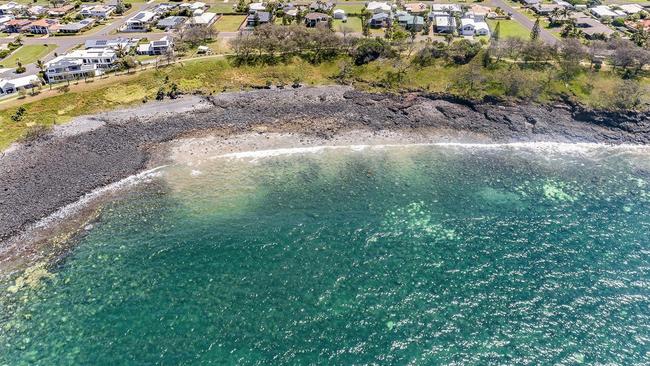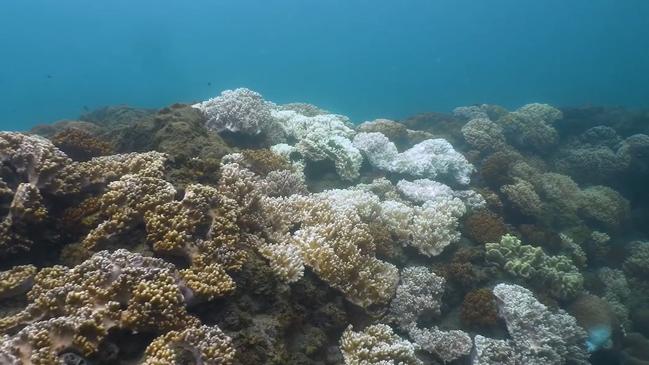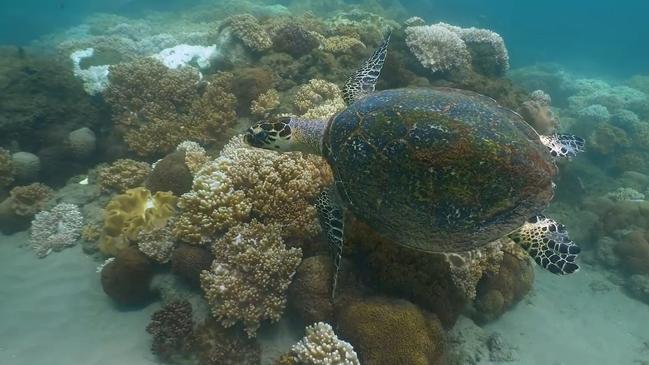Mass coral bleaching reported in Bundaberg, Hervey Bay
Coral bleaching of the Great Barrier Reef has reached the waters off Bundaberg and the Fraser Coast, with experts warning the spread is like an underwater bushfire.

Bundaberg
Don't miss out on the headlines from Bundaberg. Followed categories will be added to My News.
Surveys, sightings and studies have revealed the health of the Coral and Fraser Coast reefs are in jeopardy, with mass coral bleaching recorded at Bundaberg and Hervey Bay for the first time.
Queensland’s iconic Great Barrier Reef has suffered one of its worse mass coral bleaching events on record, with some southern reefs now impacted for the first time following the state’s sweltering summer.
The Queensland Parks and Wildlife Service confirmed coral bleaching in the Great Barrier Reef has begun to spread down the coast to inshore locations in the Capricorn Bunker, Point Vernon in Hervey Bay and Coral Cove near Bundaberg.
The Climate Council has likened the widespread event to an “underwater bushfire”.
“It took around 8000 years for the Great Barrier Reef to develop,” a spokesman said.
“Following seven mass bleaching events, including five in the past eight years, that have repeatedly damaged this complex ecosystem, the Great Barrier Reef has most likely crossed a tipping point and is fading into a new, ‘shadow state’.”
Bundaberg region divers have reported spotting the telltale bone white coral, with videos shared online depicting the spreading graveyard.
Heron Island Research Station manager and Coral Reef ecologist Dr Stuart Kininmonth said his team first noticed the coral bleaching in late January 2024, and quickly raised alarm bells.
He claimed while it was not the first time researchers had logged coral bleaching in the Capricorn Bunker region of the Great Barrier Reef, previous bleaching events were minor due to a fortunate natural occurrence on the coast.
“The reasoning being there’s an eddy of cool water that circulates in that pool between the Swains Reef and Bundaberg,” he said.
“The critical thing is a lot of the bleaching that has happened in the last five to 10 years hasn’t affected the Capricorn Bunker group, as a result the coral in this part of the world is exceptional, it’s the jewel in the crown for the Great Barrier Reef.”
But a hot summer, with strong, unrelenting north winds had prevented the water from cooling like in previous years, putting the more delicate coral of the reefs at risk.
“As a result we crossed that threshold where coral reefs like to be and they started to get heat stress and what we are seeing now is a strong result for virtually all the corals in the shallow waters,” Dr Kininmonth said.
Seasoned Bundaberg diver Steven Clark of Blue Zone Bundy said the bleaching was clear across the region, and through his near daily dives estimated roughly 20 per cent of the coral along the Bundaberg, Bargara coastline had been affected.
Mr Clark usually wears a wetsuit, mask, gloves and boots when he dives to avoid jellyfish stings, but said the recent warm water temperature had made that uncomfortable.
“It’s like hopping into a warm bath,” he said.
Hervey Bay Coral Watch ambassador Breannah Mitchell agreed with Mr Clark’s observations, and said the current state of Hervey Bay reefs was “daunting” with a lack of life and energy unseen in the years she has been swimming there.
“There was no life on the reef; hardly any fish and when you usually go diving on a healthy reef there’s a lot of crackling of the reef, but recently the reef was very silent,” she said.
Through her work with Coral Watch, Miss Mitchell has encouraged swimmers and divers to become “citizen scientists” and record the bleaching events in places government organisations often miss.
She said that unlike areas such as Barolin Rocks in Bundaberg, many reefs in Hervey Bay were not protected by Green zones, making them more exposed to the traumas of overfishing and anchoring.
She too has noticed a rise in coral bleaching across the waters of f the Wide Bay, and heartbreaking trend she hopes doesn’t continue.

There is good news however Dr Kinimonth said, with the chance for the coral to bounce back if such summer conditions do not become the trend, with bleaching not necessarily meaning the coral has died.
“For many corals they will bounce back,” he said.
“Sadly, many of the corals will run out of sugar stored away and basically they will starve and they will die.”
Despite the chance for the coral to bounce back, Dr Kininmonth said the recent mass bleaching at the southern tip of the Great Barrier Reef was undoubtedly distressing with little opportunities for scientists and marine biologists to address the root cause of rising water temperatures.
“We kind of always knew the bleaching event would happen, but we were very thankful that we had escaped previous events so to see this so widespread is distressing,” he said.
Despite positive growth and a lack of disease within coral reefs off the Bundaberg region and Fraser Coast, scientist are often left with no choice but to monitor changes tightly and look for long term solutions to ensure the reefs future health.
“The biggest question on everyone’s mind is ‘is this going to now happen every summer?,” Dr Kinimonth said.
“And if it does start to happen every summer, or even every second summer, then the corals are going to be in big trouble.”
The Department of Environment and Science said surveys undertaken in the Great Sandy Marine Park and Moreton Bay Marine Park confirmed the bleaching was in response to extended periods of elevated water temperature.
“QPWS rangers continue to monitor the affected areas and survey other areas of the marine park to determine the severity and extent of the event,” a spokesman said.
The team at the Great Barrier Reef Marine Park Authority confirmed the bleaching was becoming more and more obvious, seen even from the air in aerial helicopter surveys.
Reef Authority Director for Reef Health, Dr Mark Read offered advice to those looking to protect the health of the reef while cooler weather encourages the chance for damaged coral to bounce back.
“Know the zones that you can fish in, don’t anchor on coral, and take home your rubbish when out in the Marine Park,” he said.
“Most importantly do what you can to contribute to the global effort to reduce greenhouse gas emissions.”
More Coverage





